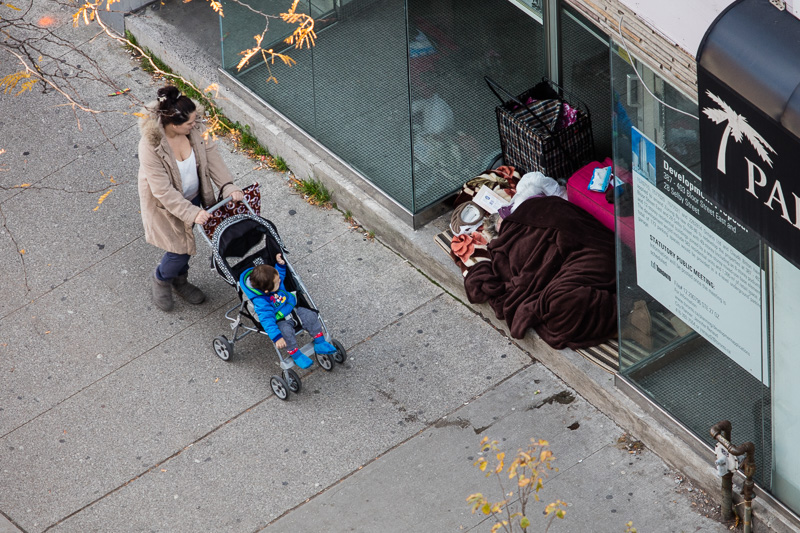I’m working on a photobook tentatively titled The Disposable City. It’s a vehicle for exploring urban concerns like ephemera, waste (garbage, demolitions, pollution), and the commodification of everything, including people. Every now and then, I do another spread, then let it sit for a time to see how I feel about it. A while back, I did one on a homeless woman who camped out for a few weeks in a doorway across from me. It seems like a reasonable piece to post on Good Friday. I’ve included the text and a few images below, but for the full impact, you can download the two spreads in pdf format.
From The Disposable City:
I live high up in a condominium on the north side of Bloor Street. Across from me on the south side, one by one, the retailers are leaving their shops as a new owner—a developer—prepares to demolish the existing structures and build a 49-story tower in their place. A homeless woman has started camping out in a doorway. The sight of her greets me in the morning as I eat my breakfast, and again at night as I get ready for bed. Each day, out of curiosity, I lean out my window and train a long lens on her. I want to know if people interact with her as they pass on the sidewalk.
What I have learned is that most people barely acknowledge her existence much less interact with her. On the preceding page are 25 shots of the same scene. In all but one, the people passing don’t appear to see her. A small child, maybe seven years old, is the only person who turns her head and looks directly at the woman. Later, another child waves from his stroller.

It would be easy to sentimentalize the scene, maybe read something Biblical into it—you must become like a child to enter the kingdom of heaven. That sort of thing. I dismiss my observations as coincidental. Like so much of photography, it’s a “framing” issue: I’ve watched for only a short time and this has allowed me to be selective in the sliver of time I choose to capture the interactions of pedestrians and a homeless woman. Those interactions just happen to play out in a way that evokes a Biblical aphorism. If I watch for long enough, my sample size will more accurately characterize the interactions. They will become more statistically representative and less Biblical.
The next morning at breakfast, I look out my window and note that a pair of Jehovah’s Witnesses have set themselves up within spitting distance of the homeless woman. The scene suggests to me a story about a certain man who lay injured in the street and the pharisees who passed him and did nothing. So much for being statistically representative!

Over the days and weeks that follow, I watch the homeless woman from my perch. I’m disinclined to suppose that my observations become statistically representative of anything. But they do become more complicated:
A man approaches from the east. He sees the homeless woman. He stops in front of her. He leans in and speaks to her. He pulls a five dollar bill from his pocket and offers it to the woman. They exchange words and then the man walks away. I’m a long way off and can’t infer much from their exchange; I assume the man asked the woman how she was, she answered, and he (taking pity on her) gave her a five dollar bill.

It isn’t until I examine the exchange on my computer monitor that I realize something different has happened. The man palmed the bill as he walked away. The homeless woman refused the offer of charity.
What a different impression of the parable we would have if the injured man lying in the street had told the Samaritan to go fuck himself.
Then again, that story may have no relevance to the scene on the street far below me. After all, the story was first addressed to a lawyer and so was told in terms he could understand. It was reasonable. Logical. And it was told in answer to a question about the definition of a word (neighbour) and not, as we usually suppose, to encourage acts of charity.
If we want to learn about charity, the stories we hear are anything but reasonable. Emphatically illogical. A woman wants to douse her master’s feet with a valuable perfume. Judas, the greatest villain of the Western canon, makes the reasonable suggestion that they sell the perfume and give the proceeds to the poor. I think it’s important to remember that it is Judas who endorses charity. Maybe it’s his unassailable logic that makes him so villainous.
In the movie, The Unforgiven, William Munny points the muzzle of his rifle. Cowering in terror, Little Bill looks up and says: “I don’t deserve this.” Munny answers: “Deserve’s got nothing to do with it.” He pulls the trigger. If he weren’t a murderer of women and children, Munny could be a religious man explaining the dark underside of a theology of grace. It’s deliciously unreasonable. And terrifying in it’s consequences.
If I am to be gracious, then I must be unreasonable. I find myself asking: what is the unreasonable way to view myself in relation to this woman? What is the unreasonable thing to expect me to do (or not to do) in answer to her presence?